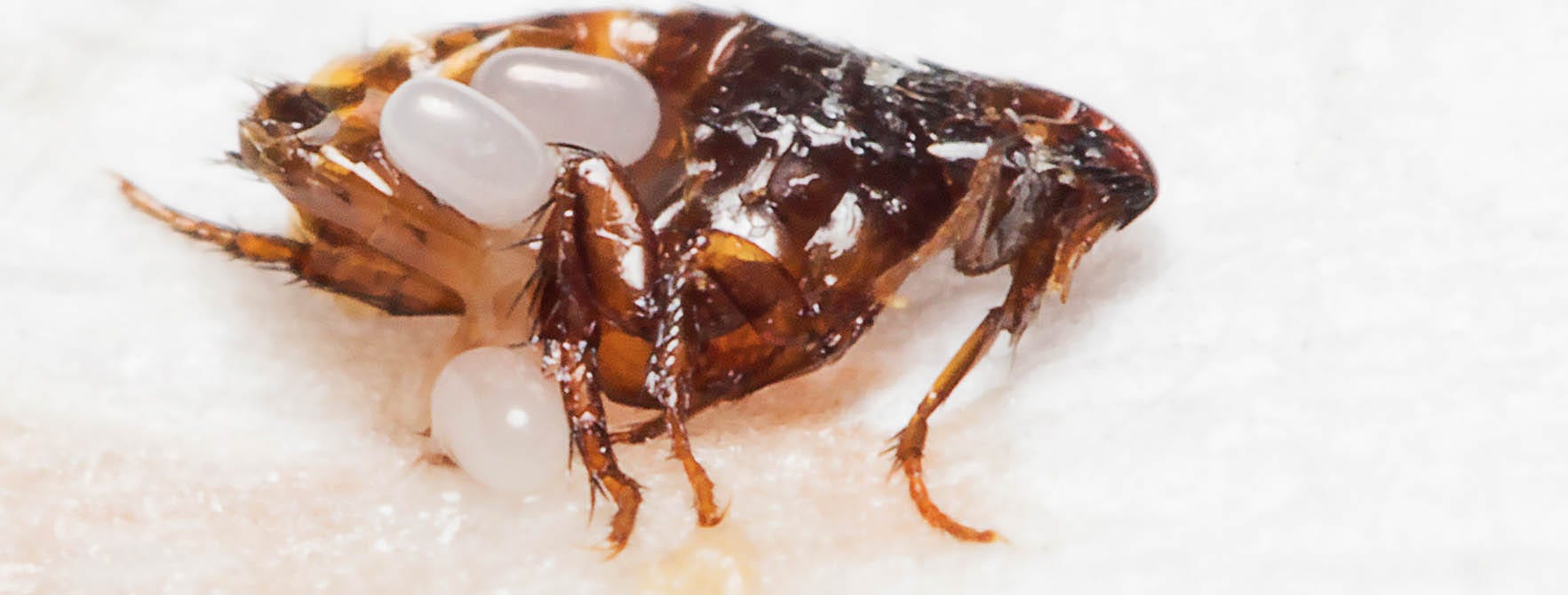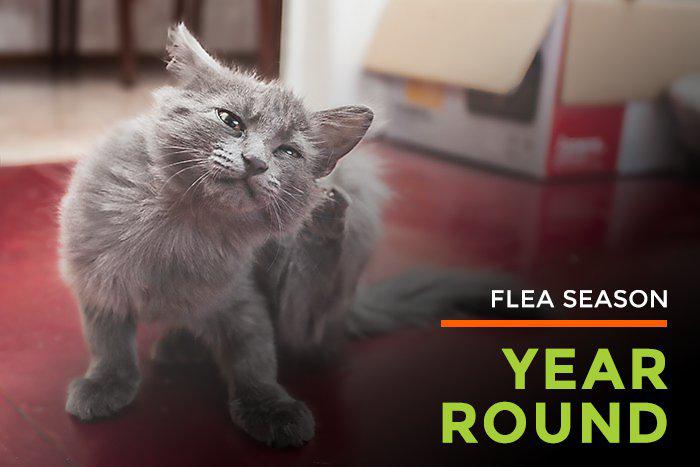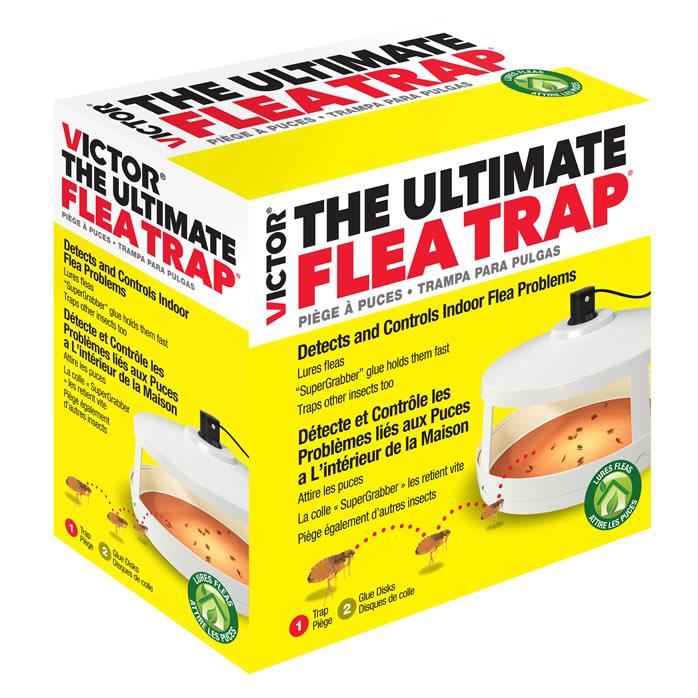
So... What's a Flea?
Fleas are small insects that can be easy to overlook. Adult fleas are generally 1/16 to 1/8 inch long, agile, dark-colored and wingless. They possess a tube-like mouth that is specially adapted to allow them to siphon blood from their hosts.
The legs of a flea are long, and the hind pair are adapted for jumping. A flea can jump up to 7 inches vertically and 13 inches horizontally. This vast jumping ability makes fleas one of the best jumpers of the animal kingdom in proportion to their body size. If a human had that sort of jump strength, he or she could leap the length of two football fields!
While jumping in fleas is well documented, not many people know that fleas also have strong eyesight that’s adapted to detect movement and changes in light intensity. That’s enough to help them quickly establish a target and make a death-defying leap to their next meal.
Fleas are considered external parasites, meaning they essentially “ride” their host and bite it repeatedly for sustenance. A flea is covered in tiny hairs that aid in the movement around a host. Despite these adaptations, fleas spend much of their lives away from a host. This means you can’t simply bathe your dog to get rid of a flea problem – you need to treat the entire house!
Different species of fleas seek out different hosts, a fact that many people overlook. Here are the most well-known fleas:
- The Oriental Rat Flea (Xenopsylla cheopis) was the flea responsible for spreading the bubonic plague.
- The Dog Flea (Ctenocephalides canis) is a flea that targets dogs, but is far less common than the Cat Flea. The Dog Flea bites cats and people, too. It’s also a parasite to many wild animals, including raccoons and opossums. Livestock can also become infested by Dog Fleas.
- The Cat Flea (Ctenocephalides felis) which feeds on cats, humans and dogs is actually the most common pest flea. It’s the species most likely to cause trouble in your house.
No matter which species of flea you are encountering, the eradication methods are all the same. Most importantly, you need perseverance and dedication to get rid of fleas. They can be difficult to completely eradicate from a home.
When is Flea Season?

Fleas are bad in the fall.
Fleas are bad in the spring.
Fleas are bad in the summer.
Fleas are bad in the winter.
Are you sensing a pattern? Yes, you got it! Every season is flea season!
Unlike many insects, fleas don’t take time off. They work year-round to get a tasty bite from you, your pets or the animals living near your home.
Since fleas hitch a ride with their hosts or lay in wait in their dens (or your house), they’re quite well-protected from the cold.
Likewise, flea eggs really benefit from an adaptation that allows their development to slow down or speed up depending on conditions. If it’s relatively humid and warm, the egg undergoes rapid development. If it’s a little too hot or a little too cold, the egg isn’t destroyed, it just waits for better conditions.
Extreme or lengthy durations of heat or cold will destroy flea eggs and kill off adult fleas, of course. Prolonged temperatures above 95 degrees F and below 30 degrees F will kill fleas in just a few days.
Fleas survive best when the temperature is between 80 degrees F and 90 degrees F, a range that’s easy to find when they’re tucked in your pet’s fur or snuggled in the den of a raccoon.
Reproduction Patterns of Fleas
Fleas lay tiny, white, oval-shaped eggs. Females can lay 45 to 50 eggs per day and up to 600 in a lifetime. Eggs are usually deposited directly on the host. As mentioned above, temperatures and humidity can alter hatching time, but most eggs hatch between 2 days to 2 weeks. Larvae are born blind, and they try to avoid bright light.
Adult fleas cannot lay eggs without a blood meal and may live up to one year without feeding. The adult flea's diet consists solely of fresh blood from mammals. New adult fleas can only live about one week without that first meal -- if they can’t find a host in that time, those new fleas die.
Fleas lay eggs in batches of 20 or more on the host, but those eggs can easily fall to the ground. This is why areas where the host rests are primary habitats of eggs and developing fleas. Outdoor deployment of eggs generally occurs in gravel, dirt patches or sandboxes to allow the newly hatched larvae access to hosts.
Optimum temperature for the flea's life cycle is 70 to 85 degrees F and optimum humidity is 70%.
Flea's Habitat
A flea can live just about anywhere. As long as it has access to a blood meal, it’s happy. In that sense, expect fleas to remain within a few hops of a host. If it is able to manage that, it has a good chance to survive. As mentioned above, fleas only spend part of their time riding their host. When not on a host, fleas are busy making a home in your home! They will hide in crevices, between rug fibers, on blankets and along the baseboards of walls.
It’s these nasty habits that make controlling fleas so difficult. You can’t just give the host dog or cat a flea bath – you need to apply flea control measures to the entire structure. Miss a spot that’s harboring eggs, and the infestation could return in a few weeks.
How to Spot the Signs of a Flea Infestation

Once it reaches a certain level, a flea infestation is hard to miss. Look for these “symptoms” around your home:
- You see black dots (the fleas) on your carpets, furniture and drapery. These fleas will be there one second and gone the next because the flea has jumped to a new location.
- Black dots appear in your pet’s fur. These are the fleas or their excrement.
- Your pets bite themselves in an effort to remove these parasites.
- Your pets scratch or lick themselves excessively.
- You have red lesions, hives or a rash around your ankles where fleas have been feeding. You may find them in a ring around your sock line.
- You experience these itchy lesions, hives or rashes in other areas of your body.
- If you’re allergic to flea bites, you may experience intense itching, shortness of breath and unexplained swelling.
You may also realize you have fleas upon returning from vacation! This happens because fleas (both adult and new hatches) have gone hungry while you and your pets were away. Upon your return, they literally run you down for a meal.
How to Get Rid of Fleas
Your first step in battling fleas is to provide relief to any of your pets who may be serving as a host. Topical treatments, baths and collar repellents are all available. After that, you need to tackle the problem in the house. Here is your attack plan:

- Pets: Treat your pets for fleas with a flea comb especially focusing around the head and neck. Next, treat your pets with a flea bath. Follow that with a regular monthly topical treatment.
- Pet Beds: Discard and destroy pet bedding. If that’s not practical, run them through the washer on hot. From then on, wash pet bedding about once a month.
- Flea Traps: The Ultimate Flea Trap™ from Victor® is a flea trap that uses heat to attract adult fleas. They are then trapped on a sticky pad and die. This helps limit the flea breeding population in your home
- Furniture: Vacuum fabric-covered furniture. Be sure to clean crevices between cushions and where fabric bunches together.
- Curtains and Drapery: Fleas will hide in curtains and floor-length drapery, so put those through a high-temperature wash. Vacuum if you can’t wash them.
- Bedding: If your pets sleep on your bed or anywhere that you use blankets, thoroughly wash them and make sure you wash them regularly.
- Carpets: Pick up all items from carpeted areas and vacuum thoroughly. Don’t forget carpeted closets.
- Flooring: Vacuum hardwood flooring, tile and other surfaces that offer places for fleas to hide.
- Diatomaceous Earth: Lightly but thoroughly apply Safer® Brand Diatomaceous Earth to areas where fleas hide, including along baseboards and in cracks and crevices. Note that Diatomaceous Earth requires careful clean up.
Victor® The Ultimate Flea Trap™

What?
The Victor® Ultimate Flea Trap™ is your ideal solution for indoor flea control. This trap eliminates fleas without the use of harmful poisons and chemicals.
How?
The Ultimate Flea Trap™ works on a simple principle: It uses the heat from a light bulb to attract fleas. They hop to the trap and stick to a glue disk. When the disk fills or becomes covered in dust, you can put in a replacement glue disk. With the replacement disk, your trap is ready to take down the next generation of fleas.
The Ultimate Flea Trap™ features a patented dome design to keep your family and pets from coming in contact with the glue. The trap boasts an unbelievable 93% catch rate, which makes the Victor® The Ultimate Flea Trap™ one of the best flea control products on the market.
When?
The Victor® The Ultimate Flea Trap™ can be used year round and draws fleas from up to 30 feet away. This trap plugs into any standard outlet.
Diatomaceous Earth

What?
Using Safer® Brand Diatomaceous Earth can quickly destroy a flea population thanks to its unique method of attacking insects. This powder is spread in strategic locations and kills fleas and other insects within 48 hours of exposure. It’s available in a 4 lb bag.
How?
Diatomaceous Earth is a mechanical insecticide, meaning insects can’t build up an immunity. This is because D.E. doesn’t rely on chemical reactions to kill insects. Instead, it’s the very makeup of D.E. that proves so deadly to fleas and other insects. While it feels like a fine powder to humans, that’s not the case with insects. When insects interact with D.E., they are exposed to microscopically small sharp edges that tear through their exoskeletons. These cuts leave their moist innards exposed and the insects dehydrate and die.
When?
Use Safer® Brand Diatomaceous Earth year round. Apply it lightly to areas where fleas and other insects hide and lay eggs. Be sure to follow application directions for the D.E. product you purchase. Did you spill some? Learn the best methods for cleaning up diatomaceous earth.
Why Choose a Solution?
Diatomaceous Earth is a poison-free option to kill fleas. It also provides lingering protection – any time after it’s been applied, it will injure and kill insects that pass through it. This trap kills fleas without exposing your pets and children to synthetic chemicals.

